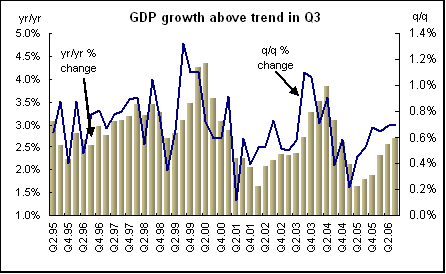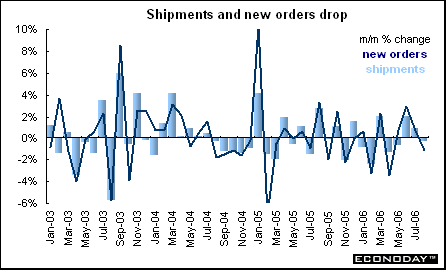After several days of dithering, OPEC (Organisation of Petroleum Exporting Countries) declared that it would cut production by 1.2 million barrels per day immediately and would consider further cuts when it meets again in December. The cartel agreed after it overcame the divisive issue of how to share the burden of cutting production and revenue. Saudi Arabia, the world's largest producer, backed the move. It also decided that the new minimum price would be $60 per barrel. The last stated minimum price for OPEC crude was about half that level and was abandoned when crude prices began to sky-rocket in 2005. Rather than tracking crude prices by the two international benchmarks - NYMEX West Texas Intermediate Cushing and the IPC Brendt Crude - OPEC calculates its own price based on a basket of 11 different crude oils. The graph below shows the London IPC price for Brendt crude. OPEC members, in the past, have been reluctant to cut production and stick to their stated quotas, especially when prices are high.

Canadian monetary policy on hold
As anticipated, the Bank of Canada maintained its 4.25 percent policy interest rate on Tuesday. Two days later, in its latest quarterly Monetary Policy Report, the Bank reduced its growth forecast slightly due to the U.S. economic slowdown. The U.S. is Canada's largest trade customer. But the Bank also said the economy would be in balance beginning in 2007 because slower U.S. growth would soften demand for Canadian goods while lagging worker productivity would limit its ability to expand. The Canadian dollar has increased about 40 percent in value against its U.S. counterpart since January 2002. This will continue to dampen export growth. Canada is the only Group of Seven country that is a major oil exporter. As a result, the country has benefited from high global energy prices that have helped push unemployment to a three-decade low and consumer spending and home prices to record highs.

The Bank lowered its gross domestic product forecast from 3.2 percent this year and 2.9 percent in 2007 to 2.8 percent and 2.5 percent respectively. But with 2008 production expected to increase 2.8 percent, the economy would remain close to capacity, which would remove the need to adjust borrowing costs. Governor David Dodge underlined the appropriateness of the current interest rate in his Thursday press conference. He said that "the current level of the policy rate is judged, at this time, to be consistent with achieving the inflation target over the medium term". The current inflation target range by agreement with the Canadian government is 1 percent to 3 percent, focusing on the 2 percent midpoint. This agreement is slated to expire at the end of this year. According to Dodge, the inflation target would be reviewed shortly.
Market week
Profit-taking in both Europe and North America Friday dampened equity results in the week. The Dow climbed through the 12,000 mark for the first time on Thursday, but it did not remain there for long as a disappointing outlook from Caterpillar provided the excuse to take profits despite an otherwise strong week of U.S. third-quarter results. (The Dow did manage to stage a Friday afternoon rally and end the week over 12,000.) U.S. market performance dampened stocks elsewhere, but only the Nasdaq was down on the week while the FTSE barely broke even (down 2 points).
Global Stock Market Recap

Europe and the UK
After a week of choppy trading, the DAX and CAC were up 0.5 percent and 0.4 percent on the week respectively as Friday's gains tipped the balance to positive. The FTSE ended virtually unchanged on the week. European stocks were bolstered by OPEC's announcement of a production cut agreement. Shares of energy companies such as BP and Total were up as a result. However, the gains eroded after U.S. equities declined and the Dow quickly fell back under the 12,000 level. In the UK, third quarter growth was higher than anticipated and the quickest pace in two years. The GDP report fueled expectations of more than one interest rate increase by the Bank of England to quash inflation. Equities, pressured by bank stocks, sagged at the prospect.

Split decision
Minutes to the Bank of England's monetary policy committee held on October 4th and 5th revealed that the two most recent appointees to the committee, Andrew Sentance and Timothy Besley, voted to increase interest rates to 5 percent. However the remaining members voted to keep the rate unchanged at 4.75 percent saying that there was no pressing need to increase interest rates in October because it might fan interest-rate expectations further and curb economic growth. However, the vote increased the odds of an increase at the November MPC meeting. Inflation exceeded the bank's 2 percent target for a fifth month in September and just released third quarter GDP data were above trend estimates. The MPC has a tendency to change interest rates in the month in which they release their quarterly Inflation Report, which is due on November 15th. The MPC next meets the week before, on November 8th and 9th.
Asia/Pacific
All Asian/Pacific equity indexes followed here were up on the week, thanks mostly to Friday's gains. These increases were the delayed response to Thursday's positive stock performance elsewhere, but especially in the U.S. where the Dow ended the trading day above the 12,000 level. Asian equities and especially those in South Korea have maintained their equilibrium despite the North Korean nuclear test about 2 weeks ago. On October 14th, the United Nations Security Council passed a resolution demanding that North Korea refrain from further tests and that it return to talks on ending its atomic weapons program. It also calls for the inspection of North Korean ships and land cargo suspected of carrying nuclear weapons-related material. North Korea called the resolution "a declaration of war." And on Friday, the Kospi was upbeat after a news report said North Korea is willing to negotiate a diplomatic settlement regarding its nuclear weapons program, if sanctions against them were dropped.

The Dow's close over 12,000 was interpreted to suggest that U.S. consumers would continue to support Asian exports. Japanese stocks were up including exporters Toyota and Nissan. However, Sony declined after second fiscal quarter earnings plummeted 93 percent as the company recalled notebook batteries because several burst into flames. Elsewhere, energy company stocks were up after the OPEC announcement curtailing production. And the Singapore's Straits Times Index (STI) climbed to a record.
Currencies
The U.S. dollar was marginally lower last week as traders adjusted their positions prior to the Federal Reserve's policy making meeting on Wednesday. Analysts anticipate that the Fed will continue to focus on inflation concerns and prospects amid signs of continuing economic growth. The currency was up on Thursday after jobless claims unexpectedly declined while housing starts posted a surprise increase. Traders now are no longer expecting a fed funds rate cut in the near future.

Earlier last week, the dollar dropped against the yen after Russia's central bank said it was adding the Japanese currency to its foreign exchange reserves. Traders sold the U.S. currency after Alexei Ulyukayev, the Russian central bank's first deputy chairman, said he may boost holdings from almost zero percent. Russia's reserves have swelled as oil prices surged. Ulyukayev said on September 13th that the central bank held 60 percent of its reserves in dollars, 33 percent in euros and 7 percent in British pound sterling.
Indicator scoreboard
EMU - September harmonized index of consumer prices was unchanged on the month and up 1.7 percent when compared with the same month a year ago. The reason for the below target reading was cheaper energy prices. Energy prices dropped 3.2 percent and were up 1.5 percent on the year. Excluding energy and unprocessed food prices, the core HICP was up 0.3 percent and 1.5 percent on the year.

August industrial output soared by 1.8 percent and was up 5.4 percent when compared with last year. The major countries all contributed to the monthly increase with German output up 2 percent, Italian up 1.2 percent, Spanish up 1.3 percent and French up 0.8 percent. Consumer durables were up 4.3 percent, consumer nondurables were unchanged, but capital goods gained 1.8 percent on the month.

August unadjusted merchandise trade balance plummeted to a €5.8 billion deficit from a surplus of €1.6 in July. However, on a seasonally adjusted basis, the trade deficit narrowed to €5.5 billion from €6.2 billion in July. August details will be available in the September report but, according to Eurostat, energy imports are mainly to blame for the deteriorating balance.

Germany - October ZEW economic outlook survey among financial experts deteriorated for a ninth month to minus 27.4 from minus 22.2 in September. However the current conditions reading improved to 42.9 from 38.9 in the previous month. The ZEW has been at odds with the Ifo business sentiment indicator which will be released next week. The ZEW is considered a forerunner to the Ifo.

September producer price index was down 0.4 percent but was up 5.1 percent when compared with last year. Prices were down for energy, petroleum products, textiles and metals as well as pork, copper and aluminum. Prices for diverse products such as printed materials, livestock feed, fruit and vegetable products along with beer and steel were up. Excluding energy, the PPI was up 0.1 percent and 2.8 percent on the year.

Britain - September consumer price index edged up 0.1 percent but was still up 2.4 percent when compared with the same month a year ago. Core CPI, which excludes energy, food, alcoholic beverages and tobacco, was up 0.3 percent on the month and 1.4 percent on the year. The transport sector, which includes petrol or gasoline prices, plummeted 2.8 percent but was still up 0.6 percent on the year. All other sectors were up both on the month. Goods prices were up 0.3 percent and 1.8 percent on the year while services prices edged down 0.1 percent but were up 3.2 percent on the year.

September claimant count unemployment jumped by 10,200 but the claimant count unemployment rate remained at 3 percent for the seventh month. International Labour Organisation (ILO) unemployment was up by 45,000 for the three months ended August when compared with the previous three months. The ILO unemployment rate remained at 5.5 percent for the third month. The increase in unemployment was attributed to more immigrants joining the labor pool faster than companies created new jobs. Employment for the same three months increased by 120,000.

Average earnings for the three month to August were up 4.2 percent when compared with the same three months a year ago. Excluding bonuses, wages were up 3.6 percent, the lowest since August 2003. Wages in the public sector were up 4.4 percent while private sector earnings gained 3.7 percent.

September retail sales declined 0.4 percent but were up 3.2 percent when compared with last year. Household goods sales sank 2.3 percent, textile, clothing & footwear dropped 0.5 percent. However food sales were up 0.8 percent while non-food sales were down 0.9 percent.

Third quarter preliminary gross domestic product was up 0.7 percent and 2.8 percent when compared with the same quarter a year ago. The main contributor to growth was the service sector which was up 0.8 percent on the quarter. Business services and finance sector was up 1.4 percent, the same as in the previous quarter. The largest contribution to growth is from other business services, which includes activities of recruitment agencies and architects & engineers. Production was up 0.3 percent, an improvement over the second quarter when production was unchanged. The stronger growth is mainly due to energy supply. Manufacturing output continues at a similar rate to the previous quarter. Transport, storage & communication sector was up 0.6 percent, maintaining similar growth to the previous quarter. Government and other services grew by 0.3 per cent in quarter three compared to 0.4 per cent in the previous quarter.

Americas
Canada - August manufacturing shipments were down 0.3 percent but up 0.1 percent when compared with last year. But if commodity price declines are taken into account, the overall volume of shipments actually increased 0.5 percent. Shipments decreased in 12 of 21 manufacturing industries in August. Durable goods shipments were down 1 percent while nondurable shipments were up 0.6 percent, thanks to increases in paper, chemicals and food manufacturing. New Orders were down 1.1 percent and 2.2 percent on the year while unfilled orders declined 0.8 percent and 0.4 percent on the year.

September unadjusted consumer price index dropped 0.5 percent and was up 0.7 percent when compared with last year. Gasoline prices plummeted 17.4 percent and accounted for most of the decline. Excluding food and energy, the CPI was up 0.6 percent and 1.6 percent on the year. Excluding only energy the CPI was up 0.5 percent and 1.8 percent on the year. Prices for women's clothing and the purchase and leasing of cars and trucks were up on the month as were homeowner replacement costs. The Bank of Canada core CPI, which excludes eight volatile items, was up 0.5 percent and 1.7 percent on the year. On a seasonally adjusted basis, the CPI was down 0.3 percent on the month but up 0.8 percent on the year.

Bottom line
Data releases last week focused on new readings for inflation. Virtually all consumer and producer price readings reflected gasoline and other energy products' price declines. However, core readings that strip out energy prices showed firmness and were skewed to the higher side.
The event highlight of this week is the FOMC meeting. Despite no expected increase, market players everywhere will be in Fed "vigil" mode as they await the conclusion of Wednesday's FOMC meeting. Elsewhere, focus will be on the Japanese CPI which is scheduled to be released Friday morning, local time.
Looking Ahead: October 23 through October 27, 2006

Anne D Picker is the author of International Indicators and Central Banks, which will be published by John Wiley and Sons in January 2007.

